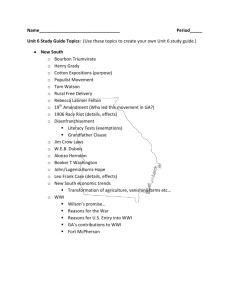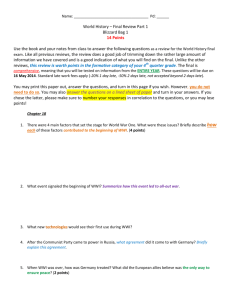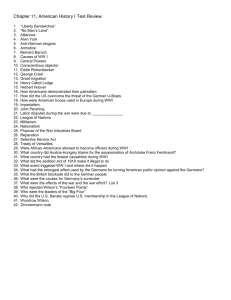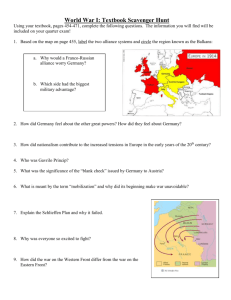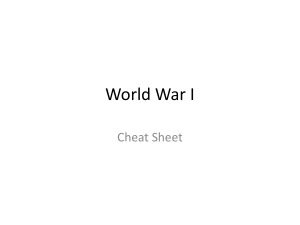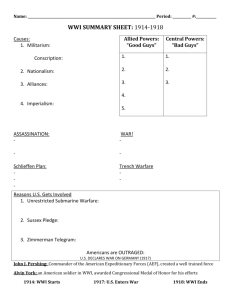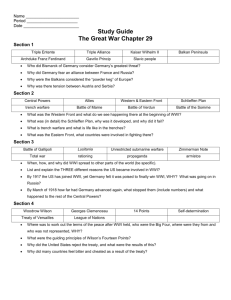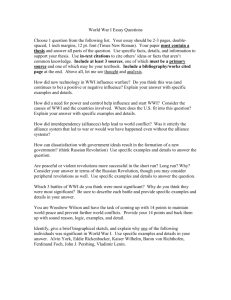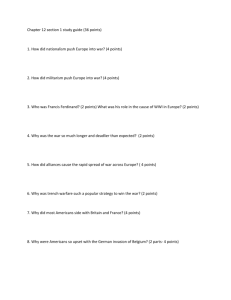WWI 4 with Pair Share
advertisement
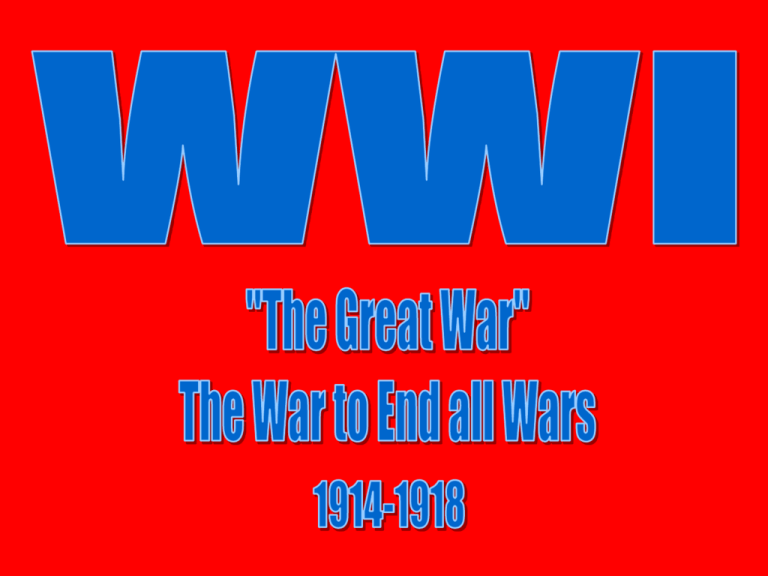
Great Britain, Belgium, France, Italy, Germany, Austria-Hungary, Serbia, and Russia were all important players in WWI Alliances • By mid-August 1914 the Central Powers primarily of Germany and Austria-Hungary. • The Triple Entente consisted of Britain, France, and Russia • The Triple Alliance consisted Germany, Austria, and Italy • Allied Powers—Britain, France, U.S. and others. Italy and Russia • Italy backed out of the Triple Alliance and Joined the Allies. • Italy was an Allie of Germany, but waited to see how the war progressed and joined the Allies in 1915. • Russia backed out of the war do to the Russian Revolution. The Russian Revolution Changed Russia from a Monarchy to a Communist Dictatorship. The Czar was removed from power and Lenin became the Father of Communism in Russia The names of the Alliances change during WWI. What nations belong to these alliances and what nations switch sides and drop out? When the WWI starts, everyone believes that it will be over by Christmas. It would last 6 to 12 weeks Everyone was horribly wrong—WWI lasted 4 years and became a war of Attrition. WWI turns out to be a very different kind of war than in the past. Why is this statement true and how does time play a role in how the war evolves. Limiting Antiwar Speech Some Americans Speak Out • Prominent Americans such as pacifist reformer Jane Addams and Senator Robert La Follette spoke out against the war. • Addams founded the Women’s International League for Peace and Freedom. • Wilson’s administration tried to limit public speech about the war. Legislation • Congress passed the Espionage Act, which punished people for aiding the enemy or refusing military duty. • The year after, it passed the Sedition Act, making it illegal for Americans to criticize the government, flag, or military in speech or writing. Opponents • More than 1,000 opponents of war were jailed under those acts, including Robert Goldstein, who directed a film called The Spirit of ‘76 and refused to remove scenes of British brutality during the American Revolution. • Socialist Party leader Eugene Debs was sentenced to 10 years in prison for criticizing the Espionage Act but was released after the war. Opponents Go to the Supreme Court • Many Americans thought the Espionage and Sedition Acts violated the First Amendment, but others thought they were essential to protect military secrets and the safety of America. • The Supreme Court also struggled to interpret the acts. • In one case, Charles Schenck, an official of the American Socialist Party, organized the printing of 15,000 leaflets opposing the war and was convicted of violating the Espionage Act. • He challenged the conviction in the Supreme Court, but the Court upheld his conviction, limiting free speech during war. • Justice Oliver Wendell Holmes Jr. wrote the Court’s unanimous decision, stating that some things said safely in peacetime are dangerous to the country during wartime. Soldiers of WWI U.S. was a Neutral Country when WWI began. The sinking of the Lusitania and the Zimmermann Note caused the U.S. to join the Allied Powers during WWI. The sinking of the Lusitania killed 128 Americans. It was attacked by German UBoats The coded telegram from Germany to Mexico, calling for Mexico to attack the U.S. Discuss U.S. involvement in WWI and why the U.S. finally gets involved. • Trench Warfare is a form of war in which opposing armies fight each other from trenches dung in the battlefield. • WWI was Total War—a conflict in which the participating countries devote all their resources to the war effort. • WWI became a stalemate—gains were small loss of life was huge due to new weapons. Body of an allied soldier lies in the road. Rats and other vermin quickly devoured any exposed flesh. Soldiers often faced the problems of rats, lice, and disease in the trenches. The body of a German soldier surfaces with the spring thaw. The human carnage was so great that bodies were often buried many times only to be blown back out by constant bombardment. Explain what Trench Warfare is. A Chain Reaction •June 28, 1914- Franz assassinated •July 28, 1914- Austria Hungary declares war on Serbia •July 30, 1914- Russia mobilizes troops towards border •August 1, 1914- Germany declares war on Russia •August 3, 1914- Germany declares war on France •August 4, 1914- Germany invades Belgium •August 4, 1914- Great Britain declares war On Germany •Mid- August, 1914- Bulgaria and Turkey Join Central Powers •Italy leaves Central Powers and joins The allies •By the end of 1914, millions Had signed up to join their Countries army - It was the thing to do - a War to end all wars - sense of pride in your country •Everyone thought it would be Over by Christmas WWI I. WWI turned out to be very different from what everyone thought it was going to be like A) Everyone expected a short, bloodless war (very few people killed or wounded) B) The war lasted over 4 years and cost the lives of 8-12 million soldiers and was fought on 2 “fronts” . C) The generals thought that it would be a war of fast moving armies, but instead it turned out to be a war of ATTRITION (who could kill more of the enemy) D) Trench warfare became the military strategy of WWI [latrines, rats, mustard gas, no man’s land] WWI II. The war was the first in which the Industrial Revolution became an important factor. A) Modern science and technology produced weapons of great destruction and killing power (the machine gun, artillery, airplane, submarine, poison gas, the tank) B) The nation(s) with the greatest resources will win the war C) It was the first world war, because so many nations were involved. III. The outcome of the war would have great importance, because it would lay the foundation for the causes of WWII What are the new weapons that are used in WWI and what is a war of attrition? Comprising the main Allied attack on the Western Front during 1916, the Battle of the Somme is famous chiefly on account of the loss of 58,000 British troops (one third of them killed) on the first day of the battle, 1 July 1916, which to this day remains a one-day record. The attack was launched upon a 30 kilometre front, from north of the Somme river between Arras and Albert, and ran from 1 July until 18 November, at which point it was called off. Discuss the battle of the Somme and why it is important. During this battle, French and British forces were able to upset the Germans plans for a quick and decisive victory. 250,000 French casualties, German casualties were estimated to be about the same. Paris Taxis bring 6,000 French reserve troops to the front lines to hold the Germans back Discuss the battle of the Marne and why it is important. The Battle of Gallipoli (sometimes referred to as the first DDay) took place on the Turkish peninsula of Gallipoli from April 1915 to January 1916 during the First World War. A joint British and French operation was mounted in order to eventually capture the Ottoman capital of Istanbul (at that point Constantinople). The attempt failed, with heavy casualties on both sides. Discuss the battle of Gallipoli and why it is important. Trench system Over the Top! What was life like for the men in the trenches. Do you think you could handle living in the trenches during WWI? Why or why not? Dugout underneath the Trench Australians resting up in a dug-out are sheltered from shelling 15 feet underground Machine Gun No mans land Artillery White AreaNo Man’s Land View of the Western Front Trenches What were tanks used for during WWI? Poison Gas Dispenser Gassed! Allied soldiers help each other to the infirmary after suffering the blinding effects of chlorine gas. Effect of Poison Gas Why was poison gas the most feared of all the weapons during WWI? Diseases such as trench fever (an infection caused by louse faeces), trench nephritis (an inflammation of the kidneys), and trench foot (the infection and swelling of feet exposed to long periods of dampness and cold, sometimes leading to amputation) became common medical problems, and caused significant losses of manpower.
